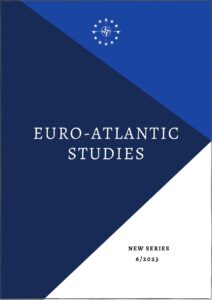Putin's Playbook: a comparison between the Russo-Georgian War and the
ongoing Russo-Ukrainian War
Putin's Playbook: a comparison between the Russo-Georgian War and the
ongoing Russo-Ukrainian War
Author(s): Alice SprînceanăSubject(s): Military policy, Present Times (2010 - today), Geopolitics, Peace and Conflict Studies
Published by: Editura Universităţii din Bucureşti
Keywords: Georgia; Russia; Ukraine; August 2008 War Donbass;
Summary/Abstract: Prior to the 2022 “special military operation” (according to Putin’s view) carried out by the Russian military in Ukraine, in 2008 Russia had another target in sight along its borders, residing in the infamously unstable region of Transcaucasia, Georgia. In an eerily similar fashion to what the current conflict unfolds in terms of Russian military prowess and display of warfare, in August 2008 the Russo – Georgian War marked the beginning of Russia’s reemergence as a military power for both the West as well as its former Soviet constituent states and further deepened the conflict between the NATO block and Russia. The latter plunged into initiating a long streak of instabilities inside the former Soviet states that broke away from the USSR. Many see the Russo-Georgian War of 2008 and the ongoing Russo-Ukrainian War as manifestations of a renewed geopolitical rivalry between major world powers. Both wars have been driven by a desire to assert Russian dominance and control over the regions in question and have led to various consequences that have had profound implications for the nations involved. In the case of Russia, the invasion of Ukraine has been seen as the biggest threat to peace and security in Europe since the end of The Cold War. However, for the first part, the Russo-Georgian war solely lasted for 5 days, (stretching from the 8th to the 12th of August), albeit tensions were carried out from earlier that year and turmoil was about to spread at any moment. The primary purpose of sending Russian troops to the separatist regions of Abkhazia and South Ossetia was to support these pro- Russian regions’ armies against the Georgian military hidden under different pretexts (i.e., “humanitarian aid” sent to repair a railway in the region of Abkhazia). For the second case, this perspective cannot be applied in the current Russo-Ukrainian war. Despite sporting a similar battle tactic in achieving its goal (keeping in mind that the conflict debuted as early as 2014 with the annexation of the Crimean Peninsula, as well as the Donbas region by sending Russian troops under the pretext of defending the local “repressed” minority from the regions of Donetsk and Lugansk, see Fig.No.1), the Russian military has marked only temporary victories at the cost of a staggering number of casualties. This comes to show that Moscow’s war plan carried out in Ukraine might become a lesson for future aggressors in regard to undermining opponents and show how miscalculations can overturn primary predictions, despite the fact that it is a major power with a bristling arsenal. Looking back at the Russo-Georgian War case, the Russians' success had permanently dented Georgia’s image in the long term. It halted the country’s progress of aligning itself with the West by adopting for the first time in 2004 under Mikhail Saakashvili’s presidency a pro-European stance, as well as deterred it from aspiring to join the EU and NATO, by solely remaining a PFP member since 1994. In the case of Ukraine, also a PFP member, but from 1995, their military has undergone training in this NATO partnership and collaboration from that period up to nowadays. Moreover, its geopolitical location, size, and implicated political and economic agents active on its territory also make it a much more valuable pawn on this imaginary chessboard between Russia and the West. NATO and the EU continue their support of Ukraine through the means of its member states that send weapons, ammunition, and many types of light and heavy military equipment, including anti-tank and air defense systems, howitzers, and drones.2 The Georgian example comes to show that the Russian rhetoric cannot be trusted and that it further continues to spread disinformation, this time around, by accusing Ukraine of staging military provocations in the Eastern Donbas region. Ironically, the Ukrainian government hasn’t had intentions of changing the status quo throughout its eight years of the ongoing war in Donbas by intervening in the occupied Lugansk and Donetsk regions, thus making it even less plausible that Kyiv would have taken such a risk amidst Russia’s largest military mobilization in decades. Putin has gone further, issuing “genocide” claims regarding killings allegedly taking place in the said region. In 2014, the Kremlin justified its military offensive by claiming ethnic Russians were being threatened in eastern Ukraine. Similar accusations were also at the forefront of Russian information warfare in 2008, when the Kremlin blamed Tbilisi for committing ethnic cleansing—a charge later dismissed by a ruling of the European Court of International Rights.3 This paper aims to draw a comparison between the similarities of the Russian forces’ applied strategies during the Russo-Georgian War of 2008, and the 2014 Annexation of Crimea and Donbas region with aftermaths in the ongoing Russo-Ukrainian war respectively, as well as question what were the factors that determined the major differences in the way these two states were perceived by the West, eventually leading to such a different timeline. Furthermore, I will attempt to analyze if one country had more probability to appease to Western political and economic interests, as well as if the geopolitical location and size of Ukraine were of more importance than Georgia’s. I will attempt to justify if Georgia was perceived as a scapegoat that prepared Ukrainian troops for similar future conflict escalations on behalf of Russia, and finally if Russia’s victory in Ukraine is even possible and what the aftermath of that action would be.
Journal: Euro-Atlantic Studies
- Issue Year: 2023
- Issue No: 6
- Page Range: 45-67
- Page Count: 23
- Language: English

